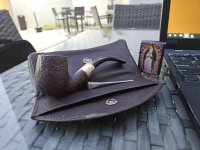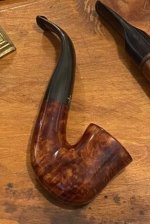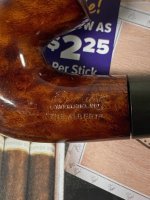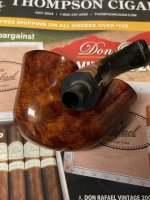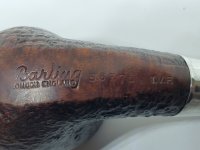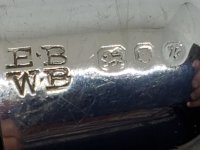Show Off Your Barlings Here
- Thread starter sablebrush52
- Start date
You are using an out of date browser. It may not display this or other websites correctly.
You should upgrade or use an alternative browser.
You should upgrade or use an alternative browser.
SmokingPipes.com Updates
Watch for Updates Twice a Week
Nice looking pipe. I agree, I don't think I've seen one quite like that, either. Good acquisition. Hope it smokes as good as it looks.Bought this today online. Sellers photos. All the other pipes in the lot were 1980s. So I’m thinking she’s a later model. I don’t think I’ve seen a calabash? before, the newer ones excluded.
A few months ago a fellow pipe smoker passed away and his family asked his best friend to distribute his pipe collection among his close friends. I wound up with four pipes, among them was this Barlings. The nomenclature is fairly hard to read, nearly worn off. Starting on the left it reads Barlings (in block letters, in an arc) over Make, over Ye Olde Wood. To the right of that is LP (LF ?) 276. To the right of that is "Fossil". To the right of that is Made In over England. To the right of that is T.V.F. From the small amount of research I've done this could be an earlier Family era pipe ? Any input is very much appreciated.
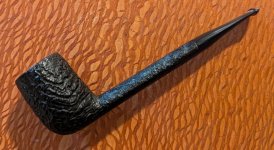

First let me say it is a beauty, for sure. Also, I am no expert on these, but I have a book on collectable pipes and there is a section on Barlings.A few months ago a fellow pipe smoker passed away and his family asked his best friend to distribute his pipe collection among his close friends. I wound up with four pipes, among them was this Barlings. The nomenclature is fairly hard to read, nearly worn off. Starting on the left it reads Barlings (in block letters, in an arc) over Make, over Ye Olde Wood. To the right of that is LP (LF ?) 276. To the right of that is "Fossil". To the right of that is Made In over England. To the right of that is T.V.F. From the small amount of research I've done this could be an earlier Family era pipe ? Any input is very much appreciated.
View attachment 321989
It would seem that Barling, a very old company, went through a transition in 1962 that lasted until 1968. Both the Pre-transition and the transition period Barlings displayed the arched BARLING'S MAKE that you find. However, only the pre-transition pipes used the three digit numbering system like you are finding. During the transition (62-68) they used a 4 digit system. After '68 the logo changed to a script vs the block letters.
The TVF stands for "The Very Finest" and I believe was a pre-transition indicator. So, by all indicators, your pipe was made sometime before 1962. It goes on to say that the "Fossils" were more rare than the smooths and were more expensive.
The only other thing I can share is do you happen to see the letter R etched just in front of the Barling name? I ask because the shape and style you show was made in an ultra rare example that was called a "Quaint." The Quaint's were not always marked with R, but were occasionally.
I hope this helps you.
What you have is a very desirable Family Era Barling made between 1947 and 1962. The dating might be tightened up if there’s a stamp on the underside of the stem, near where it meets with the shank. If there’s a REG’d number, the pipe is 1947 to early 1951. If there’s a “Barling DESIGN” stamp then it’s 1951 thru 1962.A few months ago a fellow pipe smoker passed away and his family asked his best friend to distribute his pipe collection among his close friends. I wound up with four pipes, among them was this Barlings. The nomenclature is fairly hard to read, nearly worn off. Starting on the left it reads Barlings (in block letters, in an arc) over Make, over Ye Olde Wood. To the right of that is LP (LF ?) 276. To the right of that is "Fossil". To the right of that is Made In over England. To the right of that is T.V.F. From the small amount of research I've done this could be an earlier Family era pipe ? Any input is very much appreciated.
View attachment 321989
FOSSIL is Barling’s term for a sandblast finish.
The LF stands for “long flat”, referring to the extra long shank.
This particular model is very popular with Barling collectors, more so because of the rare LF shank.
I’d need to see better pictures but you have a fairly valuable pipe, somewhere around $600 and up if condition is really exceptional.
This is from Hacker’s book. His dates are WAY off. There’s much better scholarship available today. Plus a lot of his “info” is flat out wrong. His Barling stuff is “iffy”.First let me say it is a beauty, for sure. Also, I am no expert on these, but I have a book on collectable pipes and there is a section on Barlings.
It would seem that Barling, a very old company, went through a transition in 1962 that lasted until 1968. Both the Pre-transition and the transition period Barlings displayed the arched BARLING'S MAKE that you find. However, only the pre-transition pipes used the three digit numbering system like you are finding. During the transition (62-68) they used a 4 digit system. After '68 the logo changed to a script vs the block letters.
The TVF stands for "The Very Finest" and I believe was a pre-transition indicator. So, by all indicators, your pipe was made sometime before 1962. It goes on to say that the "Fossils" were more rare than the smooths and were more expensive.
The only other thing I can share is do you happen to see the letter R etched just in front of the Barling name? I ask because the shape and style you show was made in an ultra rare example that was called a "Quaint." The Quaint's were not always marked with R, but were occasionally.
I hope this helps you.
You are exactly right on this being from Richard C Hacker entitled, "Rare Smoke." I appreciate your critique of the accuracy of the book and the dates. As I stated in reply to the poster, I have no expertise, but just that book and thought I would share info.This is from Hacker’s book. His dates are WAY off. There’s much better scholarship available today. Plus a lot of his “info” is flat out wrong. His Barling stuff is “iffy”.
Again, thanks for the update.
DIck joined a cigar board i was on, he came in full of piss and vinegar and was super opinionated which was interested because just about everything he said as "fact" was wrong, he kind of became the butt of jokes on the board, i think he got sick of being called out and corrected and he left the board. A character to be sure and thought everything he said should be taken as the gospel.This is from Hacker’s book. His dates are WAY off. There’s much better scholarship available today. Plus a lot of his “info” is flat out wrong. His Barling stuff is “iffy”.
Thank you for all this info. The stem has no markings and I have no idea if it's even original. It does have some deep tooth marks, so I would like to have a replacement made for everyday smoking. I'll try to take some better photos when I have more time.What you have is a very desirable Family Era Barling made between 1947 and 1962. The dating might be tightened up if there’s a stamp on the underside of the stem, near where it meets with the shank. If there’s a REG’d number, the pipe is 1947 to early 1951. If there’s a “Barling DESIGN” stamp then it’s 1951 thru 1962.
FOSSIL is Barling’s term for a sandblast finish.
The LF stands for “long flat”, referring to the extra long shank.
This particular model is very popular with Barling collectors, more so because of the rare LF shank.
I’d need to see better pictures but you have a fairly valuable pipe, somewhere around $600 and up if condition is really exceptional.
That's good, as it's not a quaint. The Barling I have has been over-reamed, and the nomenclature so buffed off I can read some of it only with wetting it and holding it at just the right angle in natural light. I've written in what I could make out. The word BARLINGS is arched over "MAKE".Thanks for the info. I do not see an R before the Barling name. Regardless of its market value, for me it is the sentimental value of smoking a pipe that belonged to a good friend. I will think of him every time I smoke it.

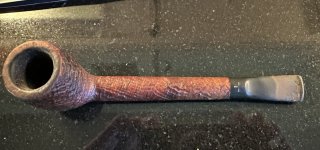
Edit:
After seeing Jesse's post, there appears to be "TV" near the bit. If there was an F there I can't see it. Funny, just had an eye exam!
Also, there's a space between the E or F and the L, which may have had another letter after it.
Last edited:
It’s a Family era Barling, made between 1947 and 1962.That's good, as it's not a quaint. The Barling I have has been over-reamed, and the nomenclature so buffed off I can read some of it only with wetting it and holding it at just the right angle in natural light. I've written in what I could make out. The word BARLINGS is arched over "MAKE".
View attachment 322005
View attachment 322006
Edit:
After seeing Jesse's post, there appears to be "TV" near the bit. If there was an F there I can't see it. Funny, just had an eye exam!
Size could be EL, which stands for extra large. TVF stands for “The Very Finest”.
There would also be a Fossil stamp, which indicates a sandblast, and a COM stamp.
Regarding Hacker, he did some pioneering work at a time when the Internet was very limited. Getting information was much more laborious. He did interview Sasieni, which is great source material. On the other hand reference materials in libraries available now were available then, and apparently weren’t used.
The big gripe I have with Hacker is that he never says, “To the best of our knowledge”. He writes like his information is an absolute. He’s wrong a lot. For example, Hacker writes that Barling never issued a catalog prior to the 150th Anniversary catalog. Never. Ever.
No question about it, and totally Wrong. 10 years ago I restored and published a circa 1914 Barling catalog.
So take his “is” and “isn’t” with a mountain of salt, look to newer sources, but don’t accept them uncritically either, unless it’s a Jon Guss, Ben Rapaport, our own greeneyes, PipePhil, and a few others who are doing some serious research. The rest, like pipe dealers, may have some facts correct, but are largely hit or miss.
The big gripe I have with Hacker is that he never says, “To the best of our knowledge”. He writes like his information is an absolute. He’s wrong a lot. For example, Hacker writes that Barling never issued a catalog prior to the 150th Anniversary catalog. Never. Ever.
No question about it, and totally Wrong. 10 years ago I restored and published a circa 1914 Barling catalog.
So take his “is” and “isn’t” with a mountain of salt, look to newer sources, but don’t accept them uncritically either, unless it’s a Jon Guss, Ben Rapaport, our own greeneyes, PipePhil, and a few others who are doing some serious research. The rest, like pipe dealers, may have some facts correct, but are largely hit or miss.
This is good stuff to know. Quite honestly, as I read Richard's book, I noticed there was a lot of emphasis on "I", "Me", "My collection." He mentions the interview with Sasieni often and I'm sure that is of much value, but anytime one reads of many absolutes with no reference to other options, one does question just how much of the gospel is being revealed.Regarding Hacker, he did some pioneering work at a time when the Internet was very limited. Getting information was much more laborious. He did interview Sasieni, which is great source material. On the other hand reference materials in libraries available now were available then, and apparently weren’t used.
The big gripe I have with Hacker is that he never says, “To the best of our knowledge”. He writes like his information is an absolute. He’s wrong a lot. For example, Hacker writes that Barling never issued a catalog prior to the 150th Anniversary catalog. Never. Ever.
No question about it, and totally Wrong. 10 years ago I restored and published a circa 1914 Barling catalog.
So take his “is” and “isn’t” with a mountain of salt, look to newer sources, but don’t accept them uncritically either, unless it’s a Jon Guss, Ben Rapaport, our own greeneyes, PipePhil, and a few others who are doing some serious research. The rest, like pipe dealers, may have some facts correct, but are largely hit or miss.
He really hammers on the information that he has on Dunhill. Now I question some of that.
Please understand I am not "piling on" with these comments, as I have enjoyed the books, but questions are arising. I know so little, but I'm trying to navigate the waters.
Please let me know what nomenclature is stamped on it.Bought this today online. Sellers photos. All the other pipes in the lot were 1980s. So I’m thinking she’s a later model. I don’t think I’ve seen a calabash? before, the newer ones excluded.
I own two Barling calabashes, which are shown at the beginning of this thread. One is a gourd calabash and the other is briar. Both date to 1908, IIRC.
Loring, a respected Dunhill authority, once wrote an article about Hacker’s errors regarding Dunhill.This is good stuff to know. Quite honestly, as I read Richard's book, I noticed there was a lot of emphasis on "I", "Me", "My collection." He mentions the interview with Sasieni often and I'm sure that is of much value, but anytime one reads of many absolutes with no reference to other options, one does question just how much of the gospel is being revealed.
He really hammers on the information that he has on Dunhill. Now I question some of that.
Please understand I am not "piling on" with these comments, as I have enjoyed the books, but questions are arising. I know so little, but I'm trying to navigate the waters.
It’s not about piling on, it’s about questioning accuracy, which is fair.
Hacker is an OK introductory read, but by no means an authoritative source.
Please let me know what nomenclature is stamped on it.
I own two Barling calabashes, which are shown at the beginning of this thread. One is a gourd calabash and the other is briar. Both date to 1908, IIRC.
Attachments
I don't travel much these days, but I always had the knack of finding a comfortable place to enjoy a pipe after work, in this no-smoking world. It's been 100 degrees for the past week, here in Maryland, pretty miserable. Tonight finds me at the Jersey shore. I booked a Sheraton, that turns out to have an event center, the outdoor patio was deserted tonight. It's 80 degrees here, with a nice breeze. I found the perfect spot to relax before bed with a 1964 Barling.
